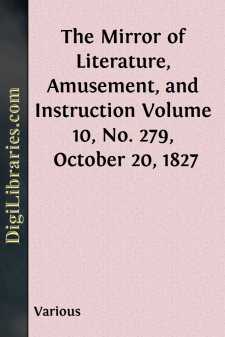Categories
- Antiques & Collectibles 13
- Architecture 36
- Art 48
- Bibles 22
- Biography & Autobiography 813
- Body, Mind & Spirit 142
- Business & Economics 28
- Children's Books 16
- Children's Fiction 13
- Computers 4
- Cooking 94
- Crafts & Hobbies 4
- Drama 346
- Education 46
- Family & Relationships 57
- Fiction 11829
- Games 19
- Gardening 17
- Health & Fitness 34
- History 1377
- House & Home 1
- Humor 147
- Juvenile Fiction 1873
- Juvenile Nonfiction 202
- Language Arts & Disciplines 88
- Law 16
- Literary Collections 686
- Literary Criticism 179
- Mathematics 13
- Medical 41
- Music 40
- Nature 179
- Non-Classifiable 1768
- Performing Arts 7
- Periodicals 1453
- Philosophy 64
- Photography 2
- Poetry 896
- Political Science 203
- Psychology 42
- Reference 154
- Religion 513
- Science 126
- Self-Help 84
- Social Science 81
- Sports & Recreation 34
- Study Aids 3
- Technology & Engineering 59
- Transportation 23
- Travel 463
- True Crime 29
The Mirror of Literature, Amusement, and Instruction Volume 10, No. 279, October 20, 1827
by: Various
Categories:
Description:
Excerpt
BRAMBLETYE HOUSE.
On the borders of Ashdown Forest, in the county of Sussex, stands the above picturesque ruin of Brambletye House, whose lettered fame may be dated from the publication of Mr. Smith's novel of that name, in January, 1826. The ruin has since attracted scores of tourists, as we were, on our recent visit, informed by the occupier of the adjoining farm-house; which circumstance coupled with the high literary success of Mr. Smith's novel, has induced us to select Brambletye House for the illustration of our present number.
Brambletye, or, as it is termed in Doomsday Book, Brambertie House, after the conquest, became the property of the Earl of Mortain and Cornwall, forming part of the barony then conferred upon him, and subsequently denominated the honour of the eagle. Passing into possession of the Andehams, Saint Clares, and several others, it came into the occupation of the Comptons, towards the beginning of the seventeenth century; and from the arms of that family impaling those of Spencer, still remaining over the principal entrance, with the date 1631 in a lozenge, it is conjectured that the old moated edifice (represented in the annexed vignette) which had hitherto been the residence of the proprietors, was abandoned in the reign of James I., by Sir Henry Compton, who built the extensive and solid baronial mansion, commonly known by the name of Brambletye House.
"From their undaunted courage and inflexible loyalty to the Stuarts," says the novelist, "the Comptons had been heavy sufferers, both in purse and person, during the eventful progress of the civil wars. The Earl of Northampton, the head of the family, and nephew to Sir Henry, the presumed builder of Brambletye, had four sons, officers under him, whereof three charged in the field at the battle of Hopton Heath, and the eldest, Lord Compton, was wounded. The Earl himself, refusing to take quarter from the rascally Roundheads, as he indignantly termed them, even when their swords were at his throat, was put to death in the same battle; and the successor to his title, with one of his brothers, finally accompanied the royal family in their exile. Sir John Compton, a branch of this family, having preserved much of his property from the committee of sequestration, displayed rather more splendour than fell to the lot of most of the cavaliers who took an equally conspicuous part against the parliament armies. Although never capable of any regular defence, yet the place being hastily fortified, refused the summons of the parliamentarian colonel, Okey, by whom it Was invested; but it was speedily taken, when sad havoc was committed by the soldiery, all the armorial bearings, and every symbol of rank and gentility, being wantonly mutilated or destroyed."
In the time of the commonwealth, Brambletye was the focus of many a cavalier conspiracy. "From its not being a place of any strength or notice, it was imagined that Brambletye might better escape the keen and jealous watchfulness, which kept the protector's eye ever fixed upon the strong holds and defensible mansions of the nobility and gentry; while its proximity to the metropolis, combined with the seclusion of its situation, adapted it to any enterprize which required at the same time secrecy, and an easy communication with the metropolis."
In the novel just quoted, which is altogether a pleasant assemblage of historical facts, aided by the imaginative garniture of the author, the denouement is brought about by the explosion of a gunpowder vault which destroyed part of the mansion; and on the marriage of his hero and heroine Brambletye House was abandoned to its fate; "and the time that has intervened since its desertion," says our author, "combining with the casualty and violence by which it was originally shattered and dismantled, has reduced it to its present condition of a desolate and forlorn ruin."
A visit to Brambletye was the immediate object of our journey, and though a distance of thirty-three miles, we considered ourselves amply requited by the pensive interest of the scene and its crowded associations....












